
Magnolia is a large genus of about 210 to 340 flowering plant species in the subfamily Magnolioideae of the family Magnoliaceae. The natural range of Magnolia species is disjunct, with a main center in east and southeast Asia and a secondary center in eastern North America, Central America, the West Indies, and some species in South America.
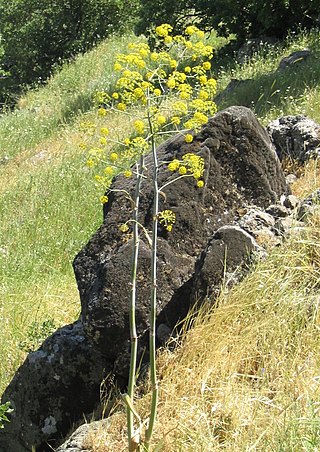
Ferula is a genus of about 220 species of flowering plants in the family Apiaceae, native to the Mediterranean region east to central Asia, mostly growing in arid climates. They are herbaceous perennial plants growing to 1–4 m tall, with stout, hollow, somewhat succulent stems. The leaves are tripinnate or even more finely divided, with a stout basal sheath clasping the stem. The basal sheaths of Ferula oopoda are up to six inches (15 cm) long and form a cup holding about a cup of rainwater, possibly to draw pollinators in an arid land. The flowers are usually yellow, rarely white, produced in large umbels. Many plants of this genus, especially F. communis, are referred to as "giant fennel," although they are not fennel in the strict sense.
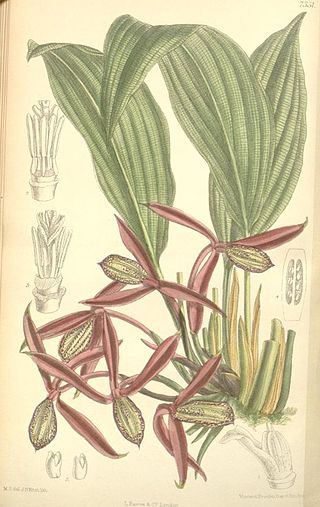
Orchidantha is a genus of flowering plants. In the APG III system, it is placed in the family Lowiaceae, as the sole genus. It includes the plants in the formerly recognised genera Lowia and Protamomum.

Oncidium, abbreviated as Onc. in the horticultural trade, is a genus that, as of December 2023, contains about 340 species of orchids from the subtribe Oncidiinae of the orchid family Orchidaceae. It is distributed across tropical and subtropical America from Mexico, Central America and the West Indies to northern Argentina, with one species (O. ensatum) extending into Florida. Common names for plants in this genus include dancing-lady orchid and golden shower orchid.

Eugenia is a genus of flowering plants in the myrtle family Myrtaceae. It has a worldwide, although highly uneven, distribution in tropical and subtropical regions. The bulk of the approximately 1,100 species occur in the New World tropics, especially in the northern Andes, the Caribbean, and the Atlantic Forest of eastern Brazil. Other centers of diversity include New Caledonia and Madagascar. Many of the species that occur in the Old World have received a new classification into the genus Syzygium.
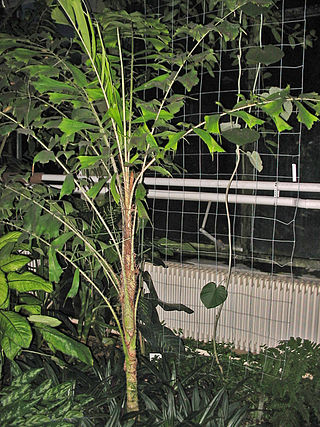
Aiphanes is a genus of spiny palms which is native to tropical regions of South and Central America and the Caribbean. There are about 26 species in the genus, ranging in size from understorey shrubs with subterranean stems to subcanopy trees as tall as 20 metres (66 ft). Most have pinnately compound leaves ; one species has entire leaves. Stems, leaves and sometimes even the fruit are covered with spines. Plants flower repeatedly over the course of their lifespan and have separate male and female flowers, although these are borne together on the same inflorescence. Although records of pollinators are limited, most species appear to be pollinated by insects. The fruit are eaten by several birds and mammals, including at least two species of amazon parrots.
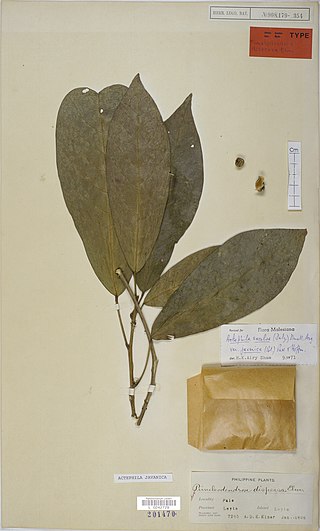
Actephila is a genus of plants in the family Phyllanthaceae, first described as a genus in 1826. It is one of 8 genera in the tribe Poranthereae, and is most closely related to Leptopus. The name of the genus is derived from two Greek words, akte, "the seashore", and philos, "loving". It refers to a coastal habitat.

Cylindropuntia is a genus of cacti, containing species commonly known as chollas, native to northern Mexico and the Southwestern United States. They are known for their barbed spines that tenaciously attach to skin, fur, and clothing. Stands of cholla are called cholla gardens. Individuals within these colonies often exhibit the same DNA, as they were formerly tubercles of an original plant.

Thismiaceae is a family of flowering plants whose status is currently uncertain. The Angiosperm Phylogeny Group classifications merge Thismiaceae into Burmanniaceae, noting that some studies have suggested that Thismiaceae, Burmanniaceae and Taccaceae should be separate families, whereas others support their merger.

Ronnbergia is a genus in the plant family Bromeliaceae, subfamily Bromelioideae. Native to South and Central America, this genus was named for Auguste Ronnberg, Belgian Director of Agriculture and Horticulture in 1874.

Galvezia is a genus of perennial plants which are native to western South America and the Galapagos Islands. The genus is currently placed in the family Plantaginaceae, having been formerly classified under Scrophulariaceae. It is named in honour of José de Gálvez, a colonial official in New Spain during the 1700s.

Wettinia is a genus of flowering plants in the palm family Arecaceae. The genus, established in 1837, contains some 20 species, but more seem to await discovery considering that 4 species - W. aequatorialis, W. lanata, W. minima and W. panamensis - were described as late as 1995. The genus is broadly divided into two groups. One group has the fruits tightly packed, while the other, formerly classified as genus Catoblastus, has fruits scattered along the inflorescence branches. It is not known whether these groups are both monophyletic. The genus is named after Frederick Augustus II of Saxony, of the House of Wettin.

Eucrosia is a genus of herbaceous, perennial and bulbous plants in the Amaryllis family distributed from Ecuador to Peru. The name is derived from the Greek eu, beautiful, and krossos, a fringe, referring to the long stamens. As circumscribed in 2020, the genus contains six species. Phaedranassa and Rauhia are the genera most closely related to Eucrosia.

Citronella aka Andreea is a genus of trees and shrubs in the family Cardiopteridaceae described as a genus in 1832. It is native to tropical regions of South and Central America, insular Southeast Asia, Australia, and islands of the western Pacific. The genus was formerly treated as belonging to the family Icacinaceae.

Sutera is a genus of annual and perennial flowering plants and shrubs of the family Scrophulariaceae mainly confined to Africa.
Guzmania confusa is a plant species in the genus Guzmania. This species is native to Ecuador and Colombia. Two varieties are recognized:
- Guzmania confusa var. confusa - Colombia
- Guzmania confusa var. foetidaRauh - Ecuador
Pseudocentrum is a genus of flowering plants from the orchid family, Orchidaceae. It is native to Central America, the West Indies and northern South America.
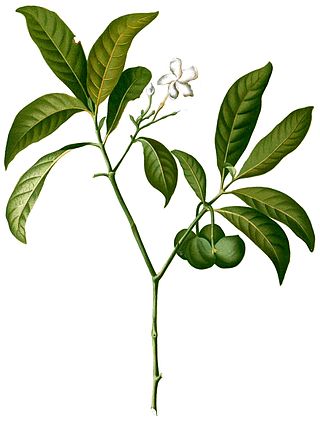
Voacanga is a genus of plants in the family Apocynaceae found in Africa, Southeast Asia, New Guinea, and Australia. As of August 2013 the World Checklist of Selected Plant Families recognises 13 species:
- Voacanga africanaStapf ex Scott-Elliot - tropical W + C + E + S Africa
- Voacanga bracteataStapf - tropical W + C Africa
- Voacanga caudifloraStapf - tropical W Africa
- Voacanga chalotianaPierre ex Stapf - tropical C Africa
- Voacanga foetida(Blume) Rolfe -Java, Borneo, Sumatra, Philippines
- Voacanga globosa(Blanco) Merr. - Philippines
- Voacanga gracilipes(Miq.) Markgr. - Maluku
- Voacanga grandifolia(Miq.) Rolfe - Indonesia, Philippines, New Guinea, Queensland
- Voacanga havilandiiRidl. - Sarawak
- Voacanga megacarpaMerr. - Philippines
- Voacanga pachycerasLeeuwenb. - Zaïre
- Voacanga psilocalyxPierre ex Stapf - Nigeria, Cameroon, Gabon, Republic of Congo
- Voacanga thouarsiiRoem. & Schult. Madagascar; widespread from Cape Province to Sudan + Senegal
- Voacanga dichotoma = Tabernaemontana pachysiphon
- Voacanga plumeriifolia = Tabernaemontana macrocarpa
Paul Edward Berry is an American botanist and curator. He is Director of the Wisconsin State Herbarium.


















